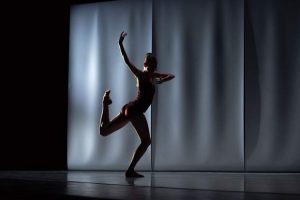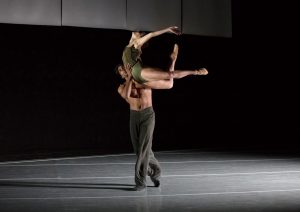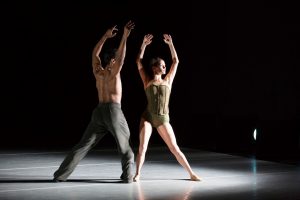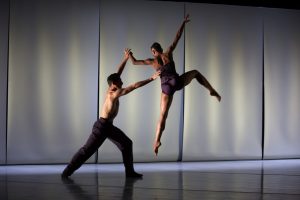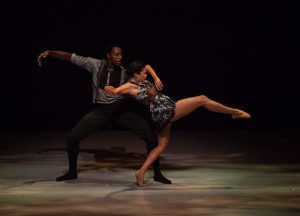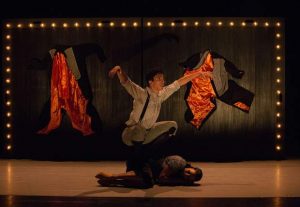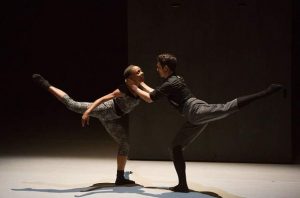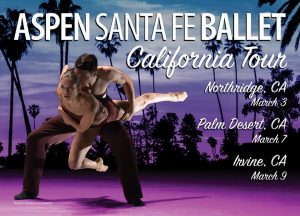FINDING HAPPINESS IN DANCE
Just before Aspen Santa Fe Ballet’s (ASFB) program, Valley Performing Arts Center’s Executive Director Thor Steingraber announced that the outfit was signed to be in residence for two more years. Based on last night’s offering, the company’s second visit here, I hope to see much more of this 20-year-old company. Even with a world premiere that ran out of steam and some cast members not completely passing this endurance test of a program, ASFB turned the transience of dance into enduring, grateful memories.
Sleepless, a work by Czech-born, Holland-based Jiřà Kylián opened the night. Born in 1947, Kylián is, remarkably enough, rarely seen in L.A.’”as opposed to Chicago and New York, where this most singular modern dance creator appears with regularity. After dancing with the Stuttgart Ballet, his uniqueness got the attention of Nederlands Dans Theater (NDT), where, in 1973, he began choreographing for the inestimable outfit. Although he stepped down as artistic director around 2000, he remains house choreographer for the wonderful company, which has gained international fame for pushing boundaries in contemporary dance with its bold repertory and astonishing virtuosity.
Based on the next piece, Eudaemonia, a world premiere by Cherice Barton, and the program’s closer, Hubbard Street Dance Chicago’s very popular Little mortal jump by Alejandro Cerrudo (whose company has also collaborated with NDT), I don’t wonder that the 11-member ASFB is on a trajectory to emulate that Den Haag-based company.
Kylián also designed Sleepless, which premiered with NDT in 2004; at the core of this edgy, enigmatic and dark work are six white tarp panels seemingly made of blackout roller shade material and placed diagonally across the stage. The only whimsy in this anxious work was when dancers use the slits between panels to play with time and space: at one point a head and a pair of hands poked through, but then the head elevates up as if someone’s body was stretching ten feet. Overall, there was a Kafka-esque, OCD atmosphere that mirrors our current anxiety-drenched world, but the 27-minute work never felt heavy or apocryphal.
The ballet began and ended with a female dancer doing a pas de deux with her own shadow, aided by designer Kees Tjebbes’ strategically placed floor lamps. In total there were three male-female duos, but there were also crucial solo turns. The severe, incisive movements matched Dirk Haubrich’s music, a slicing, crunching, crackling composition based on Mozart. In the wrong hands, this ballet could have been an incomprehensible and distancing jumble (even done perfectly, it’s still a bit one-note).
The ASFB artists made this modern dance at its most accessible. Not only did they perfectly executed Kylián’s constructions, but the physical beauty of the dancers themselves actually softened the harsh lines of a work which is hardly sensual. Whether in slo-mo or bursts of frenetic, jittery tics, each dancer was on his or her own journey, even within their pas de deux’”and all were remarkably well-suited to their partners.
The word “eudaemonia” literally means happiness. Derived from the Greek word to define a benevolent spirit, happiness, according to Aristotelian philosophy, is the result of an active life governed by reason. It is this idea that becomes the cornerstone of Cherice Barton’s world premiere (one of over 30 works commissioned by ASFB), which like so many works these days, is a great set-up with no pay-off.
It begins with the eight dancers in a chorus line laughing in slow motion. One by one they break away, their joy turning to introspection. Barton’s husband, Jeremy Jurin, mixes vocal fragments (laughing, etc.) with the music; seven artists are listed, but the selection titles are not. What is soon immediately recognizable is Jimmy Durante’s cover of “Make Someone Happy.” At this point, one dancer remains: It is ASFB’s standout player, the elegant, handsome, exotic, buff American Pete Leo Walker, whose combination of grace, beauty, classicism and athleticism already grabbed our attention in Sleepless. Filament marquis lights (designed by Seah Johnson) ring the stage floor as Walker, dressed in iconic Sinatra Style by costumer Daniela Gschwendtner, adds humor and dapper to his lists of qualities as he executes charming moves in the style of Gene Kelly (with some breakdancing tossed in). This celebration of happiness is represented by his modern-cut Fedora, which he leaves on the floor down stage.
The other dancers appear in a morphing, gelatinous clump, clearly trying to glean the same happiness from the hat. The group supports one girl to put on the hat, but it seems happiness is not so easily attained. Lit from above like an interrogation room, a ringed group therapy occurs: Stories compete with stories as each dancer strives to be heard; one even screams out loud. The moderator of the group will leave work with his own image problem.
Other vignettes will blend into each other as we see that the search for eudaemonia is eternal but results are ephemeral: dancers examine themselves in a mirror, struggling to break free from their appearance, or attempt yoga and meditation, or try self-help mantras (“Not everyone is gonna like you; Not everyone is gonna have good taste”). In the end, accompanied by Chaplin’s heartbreaking “Smile” (again covered by Durante), the artists come forward to the chorus line that started this 18-minute work; one by one, they give us a wry little grin.
Eudaemonia fits squarely in the NDT style: It’s performance art, modern dance, and mini-plays all in one. Yet whereas NDT players offer art that comes alive as an impetus for emotion, this company’”as entranced as I was with their sleek and powerful movement’”doesn’t have overall the breadth or acting chops as NDT’s players, or for that matter the psychologically raw aspects of Pina Bausch dancers. (Perhaps American dancers simply aren’t trained for this aspect of modern dance.)
Those qualities would have enhanced this problematic piece. I certainly enjoyed some episodes more than others, and absolutely fell in love with the work until halfway through when nostalgia gave way to more avant garde work. Baton took an interesting dance concept and tried to make it more theatrical; what happens at the end smacks of sweet and the work’”which stopped being about dance and more about her idea’”deflates like an overinflated tire that can’t take the goodlooking car to its final destination.
Easily the night’s crowd-pleaser is Little mortal jump, a 2012 work created for Hubbard Street Dance Chicago by its resident choreographer, Madrid-born Alejandro Cerrudo.
I’ve seen this probing and very engaging work with ten dancers; Aspen Santa Fe uses nine. Dimly lit by Michael Korsch, the eclectic score from various artists is so amazing that it should be packaged into its own CD (Desplat, Glass, Richter and Tom Waits are among the aural collection). This playful, rambunctious and endlessly inventive piece may lack gravitas but it is rich with enigmatic moments of unexplained convergences’”both between the dancers and between the styles, which are diverse as Klesmer-like vaudeville and rap funk.
The segments’”alternately whimsical, romantic and classical’”feature four large monolithic black cubes imaginatively manipulated by the dancers (set design by Cerrudo): One couple sticks trapped to the Velcro-like blocks, ultimately freeing themselves to indulge in dream-like conjugations; later, the men are briefly glimpsed through a cryptic door. Along the way they dodge these animate objects that have their own agendas of motion and displacement.
A tribute to the power of friction to create new combinations (and new geometric shapes courtesy of the elongated and funky arm gestures), Cerrudo’s choreography is taut with rapid-fire twists and frantic break-out group explosions; it’s simply a fertile fusion of fun.
As for the black, white and grey costumes by Branimira Ivanova, the girls’ outfits are a little tough to pin down (capri leggings for some and one-piece mini-dresses with a minky Midnight Lace material for others); but the suspender-wearing boys appear like stable hands from a Merchant/Ivory film.
It may be that this extraordinarily demanding evening was to blame, but not all of the Aspen dancers matched the Hubbard Street aesthetic during Little mortal jump; Joseph Watson, in particular, was a bit behind and actually seemed tired in a demanding, epic duet towards the end which, lit from the side, employs a stop motion technique. While I only noticed a few who simply did not take flight here, the others certainly encompassed a sterling combination of abstract artistry, exuberance, athleticism, and emotional shading. I was engaged the entire evening and look forward to ASFB’s return.
previous producton photos (Sleepless and Little mortal jump) by Rosalie O’Connor
Eudaemonia photos unavailable at publication
Aspen Santa Fe Ballet
Valley Performing Arts Center
18111 Nordhoff Street in Northridge
played March 3, 2017
for future events, call 818.677.3000 or visit VPAC
for more tour dates and cities, visit Aspen Santa Fe Ballet

